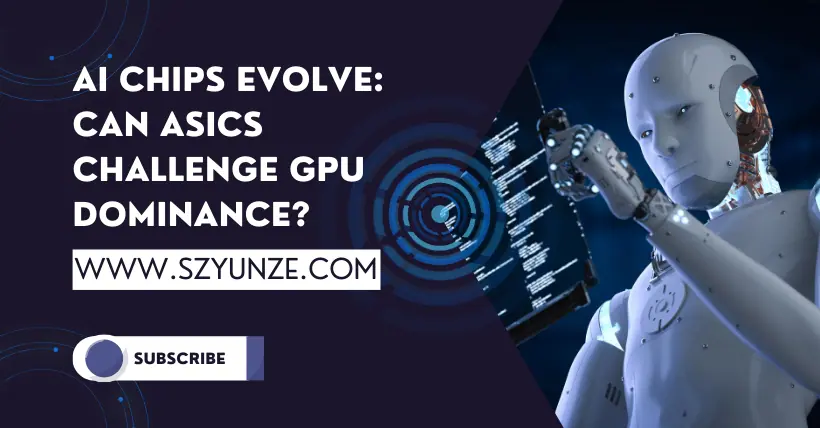NVIDIA is making a significant move into the highly sought-after application-specific integrated circuit (ASIC) market. With its deep expertise in chip design and production, combined with Taiwan’s robust semiconductor ecosystem, NVIDIA is well-positioned for success.
NVIDIA is renowned for its dominance in GPU technology, particularly in providing products for AI applications such as OpenAI’s ChatGPT. Now, the company is shifting its focus to a new frontier in the semiconductor industry—application-specific integrated circuits.
1. A Turning Point in AI Models: From Training to Inference
In recent years, AI model development has primarily focused on the pre-training phase, where massive datasets are used to train models and improve their performance. This stage demands immense computational power, making NVIDIA GPUs the preferred choice due to their powerful parallel computing capabilities.
However, pre-training has its limitations. Former OpenAI co-founder Ilya Sutskever has pointed out that the era of pre-training is nearing its end, as data—the “fossil fuel” of AI—is finite, and the available datasets for AI pre-training have already peaked.
Moreover, the marginal benefits of model scaling are diminishing, while computing costs remain high, prompting a re-evaluation of the future of AI training.
At the same time, the next phase of AI—logical inference—is becoming the new focal point. Inference involves leveraging large AI models to develop applications across various specialized fields, enabling real-world deployment.
From Google’s Gemini 2.0 to OpenAI’s GPT series, AI agents have become the primary focus of major tech companies. Unlike pre-training, inference emphasizes application and efficiency, leading to different chip requirements.
ASICs, being specialized chips, offer higher processing speed and lower power consumption for specific tasks, making them more suitable for inference and edge computing.
2. GPU vs ASIC: Which is Superior?
ASICs are custom-designed chips tailored to specific tasks, ensuring that computing power and efficiency are precisely aligned with the targeted algorithms. The number of cores, logic computing units, control units, and cache—all aspects of the chip architecture—are meticulously optimized.
As a result, ASICs achieve exceptional compactness and energy efficiency. Their reliability, security, computing power, and overall efficiency surpass those of general-purpose chips like GPUs.
For example, within the same budget, AWS’s Trainium 2 (an ASIC chip) can perform inference tasks faster than NVIDIA’s H100 GPU, offering a 30-40% improvement in cost-effectiveness. The upcoming Trainium 3, slated for release next year, is expected to double computing performance while increasing energy efficiency by 40%.
Yet, despite these advantages, GPUs have dominated the AI landscape in recent years—mainly because of NVIDIA’s overwhelming success.
NVIDIA’s rise in AI was somewhat serendipitous. When AI pioneer Geoffrey Hinton (who recently won a Nobel Prize) and his team used GPUs for AI training, they achieved groundbreaking results, revealing an unexpected goldmine for NVIDIA.
Seizing this opportunity, NVIDIA aggressively pushed GPU advancements, developing increasingly powerful chips—not just for AI but also for gaming.
With continued innovation, NVIDIA has steadily increased the core count and clock speed of its GPUs, expanding chip sizes to boost computational power. This acceleration shortens training times and speeds up product launches, a crucial competitive advantage.
Of course, higher computational power leads to increased power consumption. However, advancements in process technology and cooling solutions (such as water cooling) have kept thermal issues manageable. Most importantly, NVIDIA has also built a strong software and ecosystem strategy.
CUDA, NVIDIA’s AI development software suite, is a key competitive advantage. It simplifies AI development, allowing beginners to quickly get started. As a result, NVIDIA’s GPU solutions have gained widespread global adoption, forming a solid ecosystem.
In contrast, FPGA and ASIC development remains highly complex, making them less accessible for widespread use.
ASICs have struggled to compete with GPUs in AI due to their high costs, long development cycles, and significant risks. With AI algorithms evolving rapidly, ASICs’ lengthy development timelines pose a serious challenge.
For these reasons, GPUs have maintained their dominant position.
It’s worth noting that AI computing is divided into two categories: training and inference. Training requires immense computational power, which is why GPUs remain the primary choice for AI training.
Source: Internet
Related:

Disclaimer:
- This channel does not make any representations or warranties regarding the availability, accuracy, timeliness, effectiveness, or completeness of any information posted. It hereby disclaims any liability or consequences arising from the use of the information.
- This channel is non-commercial and non-profit. The re-posted content does not signify endorsement of its views or responsibility for its authenticity. It does not intend to constitute any other guidance. This channel is not liable for any inaccuracies or errors in the re-posted or published information, directly or indirectly.
- Some data, materials, text, images, etc., used in this channel are sourced from the internet, and all reposts are duly credited to their sources. If you discover any work that infringes on your intellectual property rights or personal legal interests, please contact us, and we will promptly modify or remove it.



